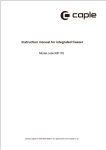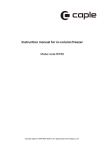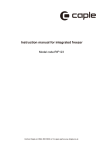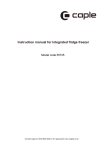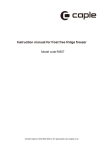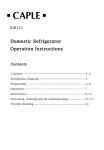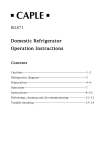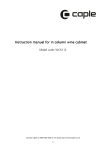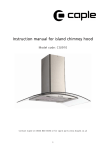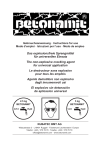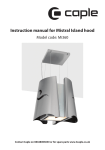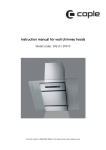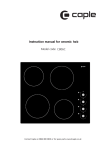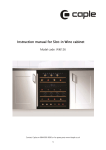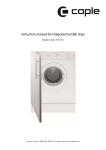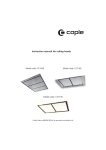Download Caple RIL123 Instruction manual
Transcript
Instruction manual for integrated larder fridge Model code:RIL123 Contact Caple on 0844 800 3830 or for spare parts www.4caple.co.uk Contents Cautions---------------------------------------------------------------------------------------------1~2 Diagram---------------------------------------------------------------------------------------------3 Preparation-----------------------------------------------------------------------------------------3 Operation-------------------------------------------------------------------------------------------4 Instruction------------------------------------------------------------------------------------------5~7 Defrosting, cleaning and de-commissioning----------------------------------------------8~9 Trouble shooting---------------------------------------------------------------------------------10 1. Compression-type appliances which use flammable refrigerants shall be marked with the symbol “Caution: risk of fire”. Caution:risk of fire The height of the triangle in the symbol “Caution: risk of fire” shall be at least 15 mm. 2. – WARNING: Keep ventilation openings, in the appliance enclosure or in the built-in structure, clear of obstruction. – WARNING: Do not use mechanical devices or other means to accelerate the defrosting process, other than those recommended by the manufacturer. – WARNING: Do not damage the refrigerant circuit. – WARNING: Do not use electrical appliances inside the food storage compartments of the appliance, unless they are of the type recommended by the manufacturer. Do not store explosive substances such as aerosol cans with a flammable propellant in this appliance. 3. If the supply cord is damaged, it must be replaced by a special cord or assembly available from the manufacturer or its service agent. This appliance is not intended for use by persons (including children) with reduced physical, sensory or mental capabilities, or lack of experience and knowledge, unless they have been given supervision or instruction concerning use of the appliance by a person responsible for their safety. Children should be supervised to ensure that they do not play with the appliance. Cautions Disposal of the old appliance Before disposing an old appliance, please make sure it’s inoperative and safe. Unplug the appliance and remove or destroy all of the springs, latches, or bolt-locks in order to avoid the risk of child entrapment. It must be noted that the refrigeration system contains insulating gases and refrigerants, which require specialised waste disposal. The valuable materials contained in a refrigerator can be recycled. Contact your local waste disposal center for proper disposal of an old appliance and contact your local authority or your dealer if you have any question. Please ensure that the pipe work of your refrigerator dose not get damaged prior to being picked up by the relevant waste disposal center Disposal of the packaging of your new appliance All the packaging materials employed in the package of your new appliance may be disposed without any danger to the environment. The cardboard box may be broken or cut into smaller pieces and given to a waste paper disposal service. The wrapping foil is made of polyethylene and the polyethylene pads and stuffing contain no fluorochloric hydrocarbon. All these valuable materials may be taken to a waste collection center and used again after adequate recycling. Consult your local authorities for the name and address of the waste materials collection centers and waste paper disposal services nearest to your house. Safety Instructions and Warnings Before starting the appliance, read the information given in the User’s Guide carefully. The User’s Guide contains very important observations relating to the assembly, operation and maintenance of the appliance. Keep the User’s Guide in a safe place and remember to hand it over to the subsequent owner, if you ever sell the appliance. The manufacturer does not accept responsibility for any damages that may arise due to non-observation of the following instruction. *Damaged appliances are not to be put into operation. In case of doubt ,consult your supplier. 1 Cautions to be carried out in strict compliance *The refrigerating circuit is leak-proof 2 Refrigerator Diagram-- Preparation 1.Shelves 2.Vegetable and fruit tray 3.Temperature Controller 4.Egg tray 5.Bottle racks This diagram may vary slightly with the layout of the refrigerator you have just purchased due to technical improvements. Preparation Unpacking Remove all packing materials. Check attachments and materials Checking should be conducted with reference to the Packing List. Contact the local distributor if discrepancies are found. Ensure proper location of the refrigerator. *Make sure the refrigerator is kept upright during handling.If an inclination is required, it should not exceed 45 degrees. Otherwise the appliance may get damaged resulting in compromised refrigeration performance. *To avoid product damage or personal injury, the refrigerator should be unpacked by two persons after it is located in a previously selected position. *Before installation,make sure the refrigerator has no visible exterior damage. *When handling the refrigerator, do not lift it by holding the worktop, to prevent any damage to the refrigerator. *Do not start up a refrigerator that is damaged. Clean the refrigerator before use. (See the following section “Cleaning”) Idle time After the refrigerator has been sited and cleaned, let it stand for more than 12 hours before connecting the power source 3 Operation Starting the refrigerator T After connecting to the power supply, turn the temperature controller clockwise from position 0 to any position between 1 and 7 to start the refrigerator. The refrigerator compressor will stop when the temperature controller is at position 0. Adjusting the temperature: The temperature inside the refrigerator is adjusted by turning the temperature controller. Positions 1 to 7 represent different temperatures from the lowest to the highest. Position Conditions 1-2 Summer or ambient temperature between25-35℃ 3-4 Spring, autumn or ambient temperature between15-25℃ 4-5 Winter, or ambient temperature between5-15℃ 6-7 Quick freeze Caution: Some time will be required for the refrigerator to reach the set level when temperature adjustments are made. The length of this period is determined by difference in the existing and set temperatures, the ambient temperature, the frequency with which the door is opened and closed and the amount of food in storage. Loading the refrigerator with food When the refrigerator is switched on, do not load food until 1~2 hours have passed. Usually, food for cold storage or deep freezing can be loaded when the temperature inside the compartment reaches the set point. 4 Instructions Cold storage is for short-term food storage or for daily consumption. Although the temperature in most parts of the cold storage compartment can be regulated between 0 and 10 degrees Centigrade, extended periods of food storage is not recommended. Cold storage should only be used for short-term storage. Cold storage compartment 1. Eggs and butter 2. Pickled food and seasonings 3. Beverages and bottled food 4. Cookies, cooked food and milk 5. Meat and sausages 6. Fruits, vegetables and salads Cautions for cold storage * Hot food must be cooled to room temperature before storing in the refrigerator Dry any water droplets on the food before placing it in the refrigerator. It is recommended that food be sealed in suitable storage bags before being placed in the refrigerator;this will prevent moisture in the food from evaporating and prevent vegetables and fruit from withering or altering in flavor. 5 Instructions * Do not store excess quantities or weights of food; food should be stored with spaces in between for better storage results. Never overload shelves, as they may collapse under excessive loads. * Food to be stored should be sorted according to consumer requirements. Food consumed daily should be placed in the most convenient area, this will minimize opening periods for the door. Do not place food too close to the internal walls. Shelf cleaning * Food holders can be taken out for cleaning Lamp: *Lamp: 240V, 1W 6 Instructions Instructions for food storage *Storage period will be extended if vegetables are placed with their roots towards the cold source. *Leaves of carrots or turnips should be removed before storage. *Put a wad of tissue on the bottle holder before placing bottles on it so that later cleaning is easier *Onions, garlic, ginger, water chestnuts and other root vegetables should not be stored in the refrigerator,as these foods are suitable for long-term storage at normal temperatures. *Ripe squash, melon, bananas and pineapples should not be stored in the refrigerator.Freezing will accelerate the ripening process. 7 Defrosting-Cleaning -De-commissioning Defrosting the cold storage compartment The cold storage compartment is designed for automatic defrosting. Frost formed on the back wall will melt and flow via the drainpipe to the evaporating container over the compressor on the back of the refrigerator, where the heat generated by the compressor will evaporate the water. Caution: Always keep the drain over the vegetable and fruit tray clear to ensure the normal flow of defrosted water. Use the rod provided to clear any blockages. Cleaning The refrigerator should be cleaned regularly to prevent the formation of bad odours. * Disconnect the power before cleaning the refrigerator. * Do not use a hard brush, steel brush, detergent, gasoline or other solvents, hot water, acid or alkali for cleaning. * Wipe water drops on the surface of the refrigerator with a soft cloth. (1) Do not use excessive amounts of water for cleaning the refrigerator (2) Use a dry cloth to clean the switch, the lamp and the temperature controller * Always keep the rubber door seal clean * Clean the back and sides of the refrigerator regularly. Prolonged power failure If the power failure lasts for an extended period, unplug the refrigerator and clean the refrigerator as previously described. Keep the door of refrigerator open when the power is turned off to prevent any food remaining in the compartment from producing bad odours. Caution: It is recommended that the refrigerator is not turned off 8 Defrosting-Cleaning -De-commissioning Power failure Even in summer, food can be stored in the refrigerator for a few hours after a power failure. * Don’t put additional food into the refrigerator during a power failure. * Avoid opening the door during power failures *If prior notice of a power failure is given, make some ice and put it in a container in the top of the cold storage compartment. Caution: temperature in the refrigerator will rise during a power failure or in the event of technical problems, and the storage period will be reduced. During Vacations * Remove any food from refrigerator is the vacation is short. Turn the temperature selection knob to the proper position, and make sure that the door of the refrigerator is properly closed. * If the vacation is long, take out the food from the refrigerator and disconnect the power. When the frost inside melts, clean and dry the compartment. Discarding * Remove the door of the refrigerator when you get rid of it, in case children may get trapped in. Moving the refrigerator * Unplug the refrigerator * Remove any food * Fix the shelf and vegetable tray with tapes *Tightly close the door with tape 9 Questions and Answers Events below are not problems: * The temperature of the refrigerator and the compressor will rise and the compressor will run for comparatively longer periods when the refrigerator is first started. * Wipe water drops on the external surface of the refrigerator with a soft cloth. * When the refrigerator is opened frequently or stays open too long in humid seasons, the cavity will become damp. * A slight sound will be heard when the liquid refrigerant circulates or when the compressor switches on and off. * A slight sound will be heard when defrosted water drops into the evaporating dish. * The compressor will operate for comparatively longer periods if excessive quantities of food are stored or the ambient temperature is high. * The evaporator will produce odours if the compartment is not cleaned. Caution:The refrigerator should never be restarted until a period of at least five minutes has elapsed. Please determine the cause of the problem before making any repairs. Problems Refrigerator will not start. The lamp does not work. Excessive noise. Causes * Bad connection to power source (plug, socket and fuse) * The temperature knob is at the 0 position * Low voltage * Bulb failure * Power supply not connected * The temperature knob is at the 0 position * Uneven placement * Contact between the refrigerator and a wall or other article Compressor operates for a long period or temperature does not reach set point. Food dry * First time of operation * Excessive food stored * Frequent opening of the refrigerator door due to hot weather * The temperature controller is not set properly * Refrigerator is in direct sunlight, or close to a heat source * Poor ventilation, or dirt on the condenser * Food not properly covered or sealed * Failure to seal food properly Strange odour * Rotting food inside refrigerator * Refrigerator should be cleaned. See "Cleaning" 10 Installation guide for built-in refrigeration Please carefully read this guide before installing the appliance. xx zz x yy y z Model X Y Z XX YY ZZ 1 1 2 RI734 540 1773 - 1778 540 550 - 560 1774 - 1782 560 2 2 RI733 550 1773 - 1778 540 560 1774 - 1782 560 RIR177 540 1773 - 1778 540 550 - 560 1774 - 1782 560 RI555 540 1773 - 1778 540 550 - 560 1774 - 1782 560 2 RI554 540 1773 - 1778 540 550 - 560 1774 - 1782 560 2 RIL177 540 1773 - 1778 540 550 - 560 1774 - 1782 560 1 RIF177 540 1773 - 1778 540 550 - 560 1774 - 1782 560 1 RIL122 540 1222 - 1224 540 550 - 560 1225 - 1233 560 1 RIF122 540 1222 - 1224 540 550 - 560 1225 - 1233 560 1 RIL88 540 873 - 875 540 550 - 560 874 - 882 560 1 RIF88 540 873 - 875 540 550 - 560 874 - 882 560 1 2 3 2 2 2 2 2 2 2 2 20 20 20 20 20 20 14 14 12 12 RI733 RIR177 RI555 RI554 RIL177 RIF177 RIL122 RIF122 RIL88 RIF88 2 2 2 20 RI734 Model 1 1 1 1 1 1 1 1 - - - 4 4 4 4 4 4 4 4 4 4 4 1 1 - - - - - - - - - - - 1 1 1 1 1 1 1 1 1 - - 1 1 1 1 1 1 1 1 1 0,9m 0,9m 1,3m 1,3m 1,8m 1,8m 1,8m 1,8m 1,8m 1,8m 1,8m 2 2 2 2 4 4 4 4 4 4 4 1 1 1 1 1 1 1 1 1 1 1 - - - - - - 1 1 1 1 1 - - - - - - 1 1 1 1 1 1 4 5 2 3 4 6 5 7 6




















